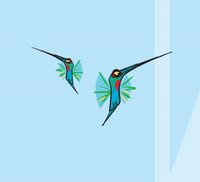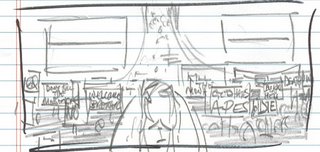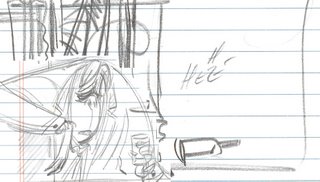

 Just wanted to talk a little about method, how I work towards an illustration and all that jazz.
Just wanted to talk a little about method, how I work towards an illustration and all that jazz.For me a book isn't really a collection of illustrations, there has to be a flow between the pages that make it work as a story. When I start out I try and do as many page flow sketches as I can. These are just tiny little sketches, one after another that try to lay out the entire book from start to finish. The first pass through will generally be disastarous, blank sections for pages you have no clue about, page spreads that just don't work, good ideas badly executed etc.
It doesn't matter, the point is to get something down. Especially for picture books where there has to be a flow, just like a film. If you could imagine a film that was shot with nothing but long shots, well, it would be unwatchable. The same goes for a picture book and finding a language, a tune to carry the story is the key to making it through. The reality is that when you start a project you might have an idea for one or two images that you want to use for key points in the story. Everything else, to a greater or lesser extent, is a battle.
The three images above represent for me the three basic types of image that I have to deal with.
The top image was in my head from day one and in reality required little thought beyond how I might achieve it. I new the composition and the software I would use to do it, it was just a matter of getting it done. I don't even think I drew a finished sketch on it beyond the thumbnail, it was that easy.
The middle image was one that I fought with every inch of the way, I tried fifty different ideas before I found a way to tell the story. I changed the angle, the composition, the color, the gag. Everything that I wanted to do would not work as a page design. It was a fucking nightmare and I abandoned version after version before I combined an idea I had for the page that followed it and this one to get to the final version. I love this page because it was so hard. I cursed like a sailor to get it done but in the end I was very happy.
The final image is one where I thought I knew what I was doing. It was one of the first images in my head and in fact I found sketches of it that dated back to the late nineties. I actually had it storyboarded because I thought that I might like to animate it long before I ever finished even writing the rest of the book. But it was wrong and because it was wrong I couldn't get beyond a certain point with it. It was so wrong that I didn't even know it was wrong and I ended up drawing the same composition again and again thinking that it was right when it was wrong. This is the worst kind of image to get done because you're so sure of it that you can't even analyze why its wrong. 'How could it be wrong, I've wanted to do this for ages' you say to yourself. But its still wrong. In the end I threw out everything I had on it and just started again. The only rule was that I wasn't allowed to draw the same thing again. And what d'ya think happened? I found a way to get it done and in truth it wasn't so different from where I'd begun, but it was different enough to have frustrated me for six weeks.
So anyway, thats how art and design boil down for me. You have 3 types of image. The kind that you know how to do, the kind you don't know how to do and the last and worst sort, the kind you've fooled yourself into thinking you know how to do.

















